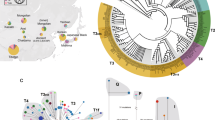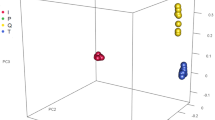Abstract
The limited ranges of the wild progenitors of many of the primary European domestic species point to their origins further east in Anatolia or the fertile crescent1,2. The wild ox (Bos primigenius), however, ranged widely3 and it is unknown whether it was domesticated within Europe as one feature of a local contribution to the farming economy1,2,4. Here we examine mitochondrial DNA control-region sequence variation from 392 extant animals sampled from Europe, Africa and the Near East, and compare this with data from four extinct British wild oxen. The ancient sequences cluster tightly in a phylogenetic analysis and are clearly distinct from modern cattle. Network analysis of modern Bos taurus identifies four star-like clusters of haplotypes, with intra-cluster diversities that approximate to that expected from the time depth of domestic history. Notably, one of these clusters predominates in Europe and is one of three encountered at substantial frequency in the Near East. In contrast, African diversity is almost exclusively composed of a separate haplogroup, which is encountered only rarely elsewhere. These data provide strong support for a derived Near-Eastern origin for European cattle.
This is a preview of subscription content, access via your institution
Access options
Subscribe to this journal
Receive 51 print issues and online access
$199.00 per year
only $3.90 per issue
Buy this article
- Purchase on Springer Link
- Instant access to full article PDF
Prices may be subject to local taxes which are calculated during checkout


Similar content being viewed by others
References
Smith, B. D. The Emergence of Agriculture (Scientific American Library, New York, 1995).
Harris, D. R. in The Origins and Spread of Agriculture and Pastoralism in Eurasia (ed. Harris, D. R.) (UCL, London, 1996).
Epstein, H. The Origin of the Domestic Animals of Africa (Africana, New York, 1971).
Bökönyi, S. The History of Domestic Animals in Central and Eastern Europe (Akadémiai Kiadó, Budapest, 1974).
Loftus, R. T., MacHugh, D. E., Bradley, D. G., Sharp, P. M. & Cunningham, P. Evidence for two independent domestications of cattle. Proc. Natl Acad. Sci. USA 91, 2757–2761 (1994).
Bradley, D. G., MacHugh, D. E., Cunningham, P. & Loftus, R. T. Mitochondrial diversity and the origins of African and European cattle. Proc. Natl Acad. Sci. USA 93, 5131–5135 (1996).
Bailey, J. F. et al. Ancient DNA suggests a recent expansion of European cattle from a diverse wild progenitor species. Proc. R. Soc. Lond. B 263, 1467–1473 (1996).
Richards, M. B., Macaulay, V. A., Bandelt, H.-J. & Sykes, B. C. Phylogeography of mitochondrial DNA in western Europe. Ann. Hum. Genet. 62, 241–260 (1998).
Rogers, A. R. & Harpending, H. Population growth makes waves in the distribution of pairwise genetic differences. Mol. Biol. Evol. 9, 552–569 (1992).
Fu, Y.-X. Statistical tests of neutrality of mutations against population growth, hitchhiking and background selection. Genetics 147, 915–925 (1997).
Excoffier, L. & Schneider, S. Why hunter-gatherer populations do not show signs of Pleistocene demographic expansions. Proc. Natl Acad. Sci. USA 96, 10597–10602 (1999).
Cymbron, T., Loftus, R. T., Malheiro, M. I. & Bradley, D. G. Mitochondrial sequence variation suggests an African influence in Portuguese cattle. Proc. R. Soc. Lond. B 266, 597–603 (1999).
Troy, C. S. Mitochondrial DNA Phylogeny and Biogeography of Domestic Cattle. Ph.D Thesis, Univ.-Dublin (1998).
Macaulay, V. et al. The emerging tree of West Eurasian mtDNAs: a synthesis of control-region sequences and RFLPs. Am. J. Hum. Genet. 64, 232–249 (1999).
Wendorf, F. & Schild, R. Nabta Playa and its role in northeastern African prehistory. J. Anthropol. Archaeol. 17, 97–123 (1998).
Yang, D. Y., Eng, B., Waye, J. S., Dudar, J. C. & Saunders, S. R. Technical note: improved DNA extraction from ancient bones using silica-based spin columns. Am. J. Phys. Anthropol. 105, 539–543 (1998).
MacHugh, D. E. et al. Early mediaeval cattle remains from a Scandinavian settlement in Dublin: genetic analysis and comparison with extant breeds. Phil. Trans. R. Soc. Lond. B 354, 99–109 (1999).
Anderson, S. et al. Complete sequence of bovine mitochondrial DNA. J. Mol. Biol. 156, 683–717 (1982).
Felsenstein, J. PHYLIP: Phylogeny Inference Package. (University of Washington, Seattle, 1993).
Schneider, S., Roessli, D. & Excoffier, L. ARLEQUIN Ver. 2.0: a Software for Population Genetics Data Analysis (Department of Anthropology, University of Geneva, Switzerland, 1999).
Bandelt, H. J., Forster, P., Sykes, B. C. & Richards, M. B. Mitochondrial portraits of human populations using median networks. Genetics 141, 743–753 (1995).
Macaulay, V. A. CRED: Credible Regions for Coalescence Times. (Univ. Oxford, 1998).
Acknowledgements
We thank C. Hawkes, O. Ertugrul, A. H. Al Haboby, A. H. Harba, M. A. A. El-Barody, E. Thompson, T. Goodchild, H. Halila, A. Swaid, G. Guneren, B. Tekbas, M. Bruford, B. Sauveroche, G. Kana, D. Achu-Kwi, M. Diallo, L. Gnaho, K. Papadopolous, A. G. Georgoudis, C. Gaillard, O. Hanotte, E. Rege, the Nordic GeneBank and C. Hawes for assistance or provision of samples. We also thank the Highland Cattle Society and the Black and Belted Galloway Societies for sample information. This work was partly funded by a European Commission contract. D.E.M. was supported by a Wellcome Trust Fellowship in Bioarchaeology. J.F.B. is a European Commission Marie Curie Fellow. Radiocarbon dating at the Oxford Radiocarbon Accelerator Unit was funded by NERC.
Author information
Authors and Affiliations
Corresponding author
Rights and permissions
About this article
Cite this article
Troy, C., MacHugh, D., Bailey, J. et al. Genetic evidence for Near-Eastern origins of European cattle. Nature 410, 1088–1091 (2001). https://doi.org/10.1038/35074088
Received:
Accepted:
Issue Date:
DOI: https://doi.org/10.1038/35074088
This article is cited by
-
Mutant alleles differentially shape fitness and other complex traits in cattle
Communications Biology (2021)
-
BoLA-DRB3 gene haplotypes show divergence in native Sudanese cattle from taurine and indicine breeds
Scientific Reports (2021)
-
Evidence for independent domestication of sheep mtDNA lineage A in India and introduction of lineage B through Arabian sea route
Scientific Reports (2021)
-
The WC1 γδ T cell pathogen receptor of ruminants is preserved in the genome of ancient extinct auroch
Immunogenetics (2021)
-
Selection signatures in tropical cattle are enriched for promoter and coding regions and reveal missense mutations in the damage response gene HELB
Genetics Selection Evolution (2020)
Comments
By submitting a comment you agree to abide by our Terms and Community Guidelines. If you find something abusive or that does not comply with our terms or guidelines please flag it as inappropriate.



